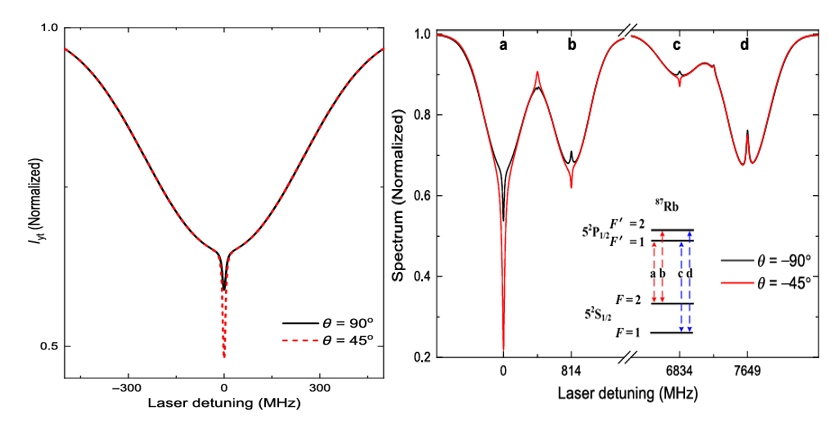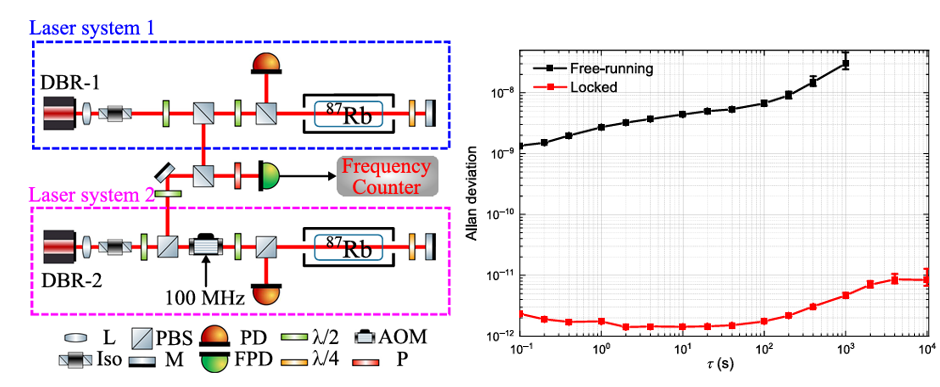Recently, an atomic clock research team from the NTSC proposed and implemented a compact optical clock based on quantum interference enhanced absorption spectroscopy, which is expected to play an important role in micro-positioning, navigation, timing (μPNT) and other systems.
Inspired by the successful story of coherent population trapping (CPT) based chip-scale microwave atomic clock and the booming of optical microcombs, chip-scale optical clock was also proposed and demonstrated with better frequency stability and accuracy, which is mainly based on two-photo transition of Rubidium atom ensemble.
However, the typically required high cell temperatures (~100 ℃) and laser powers (~10 mW) in such configuration are not compliant with the advent of a fully miniaturized and low-power optical clock.
In order to further promote the development and application of compact optical clocks, the NTSC researchers propose and demonstrate a compact optical clock rely on the detection of enhanced-absorption sub-Doppler resonances on the D1 line of the Rb atom.
In this configuration, scientists use monochromatic light and appropriate polarization settings for the counterpropagating pump and probe beams, enhanced transmission or absorption of sub-Doppler resonances is observed due to the constructive or destructive interference of two dark states prepared by the pump and probe beams, respectively. The observed absorption-enhanced Doppler-free resonance with high ratio of signal amplitude to linewidth is favorite to implement a high-performance optical clocks.
What’s more, the spectroscopic lines are obtained for modest laser powers (around 100µW) and cell temperatures (around 40°C), all these features are of significant interest for demonstrating a compact optical reference.

Fig. 1. Theoretically calculated (left) and experimentally observed (right) spectroscopic signals in proposed method.(Image by Peter Yun)
The researchers have presented a theoretical model that highlights the significant contribution of Zeeman dark states in this spectroscopic scheme. As shown in Fig. 1., the theoretically calculated spectroscopic signals agree well with the experimental observations.

Fig. 2. Compact optical clocks implemented with enhanced-absorption of sub-Doppler resonances, experimental setup (left) and measured laser frequency stability (right).(Image by Peter Yun)
To measure the frequency stability of this optical clock, two identical diode lasers are frequency-stabilized onto enhanced-absorption sub-Doppler resonances (shown in Fig. 2). The influence of key parameters on the sub-Doppler resonance features is thoroughly investigated. Using this simple-architecture setup, the researches demonstrate the locked laser beat-note with a fractional frequency stability of 1.8 E−12 at 1s and below E−11 at 10000 s, which is improved by more than 2 orders of magnitude compare with the free-running case. These results demonstrate the potential of this scheme for the implementation of a compact or even chip-scale optical frequency reference, which might find applications in instrumentation, navigation, and metrology.
This work is a cooperation with Prof. Rodolphe Boudot from FEMTO-ST in France, and the results were published in PHYSICAL REVIEW APPLIED.
 Print
Print